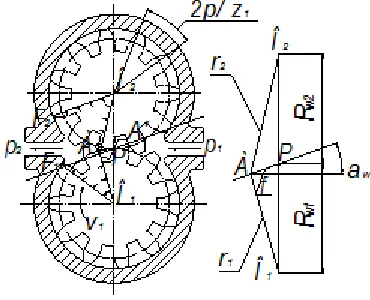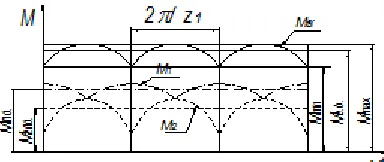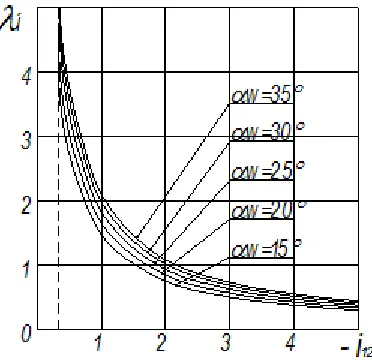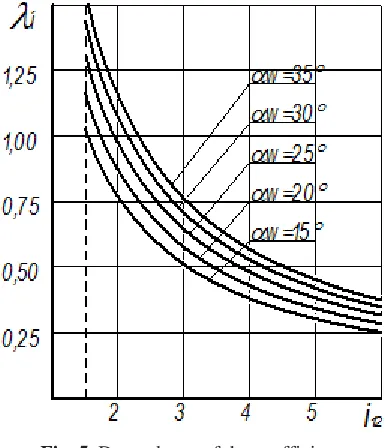* To whom all correspondence should be addressed. E-mail: iis_kfu@mail.ru
Analysis Workflows Gear Hydraulic Machines
Ildar Ilgizarovich Salakhov*, Ildus Rifovich Mavleev, Vladimir Vladimirovich Voloshko, Ilnur Dinaesovich Galimyanov
and Rayaz Takhaviev Khalimovich
Naberezhnochelninsky Institute (branch) «Kazan Federal University», Russian Federation, 423812, Naberezhnye Chelny, pr.Syuyumbike, 10A,
http://dx.doi.org/10.13005/bbra/2097
(Received: 07 March 2016; accepted: 14 April 2016)
The analysis workflow in a gear hydraulic machines of different designs. Coefficients of redistribution of moments from unbalanced hydrostatic forces. The dependences of the changes in the coefficients of redistribution of moments from the main parameters of the teeth.
Key words: Gear hydraulic, continuously variable transmission, differential hydra-mechanical variator, mechanical diagram, high-torque differential hydra-mechanical variator.
Due to the simplicity of the design, gear hydraulic machines are commonplace as non-regulated pumps used to supply non-adjustable pumps applied for small capacity hydraulic transmission with throttle control for lubrication supply and the systems control supply. Geared hydraulic transmission machines are the reversible mechanisms, being the simplest and having the lowest cost of all hydrostatic machines. However, they have failed to find a wide application in the transmission vehicles due to the complexity of continuous variable torque provision at the output shaft and its rotation speed change. The problem of the geared hydraulic machines regulation is solved by their converting into hydro-mechanical differential mechanisms1.
Forces and torques in gear hydraulic machines
The use of the geared motors and hydraulic pumps as actuating mechanisms in the differential hydrostatic transmissions is based on their following properties2, 3:
- Geared hydraulic machines can easily be transformed into a differential mechanism, where the central gear is leading in case of the hydraulic pump, or driven in case of the hydraulic motor; the gears scoring at least two and installed on the axes in a moving body are the satellites;
- The flow rate value on each of the gears varies with the size of the gears and, consequently, with the change of the gear transmission ratio there between;
- The flow rate addition occurs partly due to the forces in the toothed wheel gearing interaction by power transmission from one gear to another, and partly due to overcoming of the resistance moments caused by the action of unbalanced hydrostatic forces of fluid pressure, which create unequal circumferential moments on each of the gears.
hydraulic pump gears are replaced by flat systems, in which the point A is a gearing point at a given moment of time t. The direct line O1A = rρ1 and
O2À = ρ2 connecting this point with the gear center, and the direct O1F1 and O2F2 separate the suction and the injection areas.
By a uniform rotation of the gears, the power imparted to the working fluid:
dV
p
p
dV
p
н=
(
2−
1)
...(1)where dV – the volume pumped into the pressure line during the time dt; p1, p2 – suction pressure and discharge respectively, MPa; pí – pump pressure, MPa.
This energy is brought to the liquid as moments M1 and M2 supplied from the driving shaft to the gears for overcoming of loads, which occur on the gears due to unbalanced hydrostatic forces. Neglecting the losses, the balance of power on two gears shall be as follows:
dt M M
d M d
М
dV
pн = 1 ϕ1+ 2 ϕ2 =( 1ω1+ 2ω2) ,
...(2) where M1, M2 – moments of resistance on the master and the slave wheels, N·m; ω1, ω2 – angular velocity of rotation of driving and driven wheels; ϕ1, ϕ2 – be the angles of rotation of the respective gears.
2
2 2 2
2 2
ρ
−
=
aн
R
b
p
М
...(4)where b – the width of the gears, M; Ra1, Ra2 – the radii of the circumferences of the tops of the teeth, m.
The mean value of torque on the diving gear is calculated for them, as for other hydraulic machines, by the formula:
π
2
н о иp
V
M
=
...(5)where V0 – the working volume of the hydraulic machine, m3.
Bearing in mind that the pump supply presents a volume change in a time period, we get the following:
) (
2 1
2 2 2 2 1 1 2 2
2 2
1 1 2 2 1 1
ω ω ρ ρ ω ω ω
ω
ω + = + − −
=
= a a
н
R R b p
M M dt dV
Q ...(6)
The distances ρ1 and ρ2 can be determined from Figure 1 by the cosine law.
)
90
cos(
2
12 2
1 2
1
R
wf
R
wf
α
wρ
=
+
−
−
...(7)) 90 cos(
2 2
2 2
2 2
2 Rw f Rw f
α
wρ
= + − + ...(8)where Rw1 è Rw2 – the radii of the pitch circles of the gears, m; f – the distance from the hooking points to the pole, m; αw – pressure angle, º.
The final formula for determining the pump flow shall be written as follows:
⎥
⎦
⎤
⎢
⎣
⎡
⎟⎟
⎠
⎞
⎜⎜
⎝
⎛
+
−
=
2 1 2
1
1
2
ww
R
R
f
K
b
Q
ω
...(9)where
⎟⎟
⎠
⎞
⎜⎜
⎝
⎛
−
−
+
=
2 1 21 2 1 2
2 2
1 w w w
w w a
a
R
R
R
R
R
R
R
K
– coefficient depending only on the geometry of the gears, m2.
Instantaneous torque value on the shaft of the hydro-pump driven by one external gearing wheel can be determined from the energy balance. Having in mind, that on the one part the pump
supply flow
н
p M M dt dV
Q= = 1ω +1 2ω2
, and on the
other part V =Q/n1, we shall obtain the following: Fig. 1. Kinematic scheme for calculation
of the feed pump with one driven wheel
The moments Ì1 and Ì2 shall be determined by the following formulas:
2
2 1 2
1 1
ρ
−
=
aн
R
b
p
М
1 2 2 1 1 2 2 1 1 1 1 2 ω ω ω ω ω ω
π M M
M M Q p n Q p М = н = н = + = + ...(10)
That means, part of the flow rate is taken up directly on the driving gear (on the hydraulic pump shaft), and the other part - on the driven wheel of the hydraulic pump, and is transmitted through the gear ratio from the driven wheel to the hydraulic pump shaft. The moments change schedule from the output rotation angle of the pump shaft is shown in Figure 2.
Taking into the account the formula (9), the expression (10) shall be written as:
⎥
⎦
⎤
⎢
⎣
⎡
⎟⎟
⎠
⎞
⎜⎜
⎝
⎛
+
−
=
2 1 21
2
w w нR
R
f
K
b
p
М
...(11)One duty cycle of the machine corresponds to the gears rotation to the angular pitch of 2π z1 (z1 – a number of teeth of the pinion). The point of teeth contact is moved along the line of engagement. This causes a variability of supply, and consequently – of the torque during the working cycle4, 5.
At quadratic law of the moment change, the values Ìmax and Ìmin enable to determine the mean value of the moment Ìè.ò.
⎥ ⎦ ⎤ ⎢ ⎣ ⎡ ⎟⎟ ⎠ ⎞ ⎜⎜ ⎝ ⎛ + − = Δ − = 2 1 2 max . . 1 12 2 3 / w w bn н т и R R p K b p М М М ...(14)
The average (theoretical) values of the resistance moment M1 and M2 can be expressed in terms of the driving and driven gears supply respectively, at turning to an angle step.
1 1 1
ω
ср н срQ
p
М
=
...(15)2 2 2
ω
ср н срQ
p
М
=
...(16)1 1 1
1
V
z
n
Q
ср=
шаг ...(17)2 2 2
2
V
z
n
Q
ср=
шаг...(18) where V1øàã – volume of working liquid delivered by the gear pump leads when you turn on the angular step 2ð/z1; V2øàã – volume of the working fluid supplied by the hydraulic pump driven wheel when turning at the angular pitch 2ð/ z2.
[
]
∫ ∫ − − − + − − = = 1 2 1 2 ) 90 cos( 2 2 1 2 2 1 2 1 1 1 1 f f w w w a b f fшаг R R f R f df
R b dV V α ; ...(19)
[
]
∫ ∫ − − + + − − = = 1 2 1 2 ) 90 cos( 2 2 2 2 2 2 2 2 2 2 2 f f w w w a b f fшаг R R f R f df
R b dV
V α .
...(20) According to the theory of gearing
b
R
dt
df
=
ω
...(21)
where Rb – the radius of the basic circle of the gears, m.
w b
mz
R
cos
α
2
=
, ...(22)where m – module gear, m.
For the case, when the engagement length
is equal to the unit (å = 1),
2 2 1 bn p f
f = = ,
⎥ ⎦ ⎤ ⎢ ⎣ ⎡ − + − −
= cos(90 )
2 12 ) ( 2 1 2 3 2 1 2 1 1
1 a w bn bn bn w w
b шаг R p p p R R R b
V α ,
Fig. 2: Points in the hydraulic pump with one drive wheel
It is known from the theory of gearing that at turning within the angular pitch the segments
r1 and r2 length varies according to a parabolic law. Geometric values characterizing the gearing enable to express the dependence of the hydraulic machine moment on the gear angle.
The maximum value Mmax is at f = 0:
K
b
p
М
н2
max
=
...(12)The minimum value Mmin at f = pbn/2 (pbn = πmcosáw – the main gearing step).
⎥ ⎦ ⎤ ⎢
⎣ ⎡
+ +
− −
= cos(90 )
2 12 ) (
2 2
2 3 2
2 2
2 2
2 w w
bn bn bn w a b
шаг R
p p p R R R
b
V α
and taking into account the equation (22), the expressions for the theoretical moments of resistance can finally be written as follows:
⎥ ⎦ ⎤ ⎢
⎣ ⎡
− +
− −
= cos(90 )
2 12
2 1
2 2
1 2
1
1 w w
bn bn w a
н
ср R
p p R R b p
М α ;
...(23)
⎥ ⎦ ⎤ ⎢
⎣ ⎡
+ +
− −
= cos(90 )
2 12
2 2
2 2
2 2
2
2ср н a w bn bn Rw w
p p R R b p
М α .
...(24) The ratio of the resistance moments in the driving and driven gears can be presented through the coefficient λí, which is defined as
[ ]
[ w w ] w
w w
w
ср ср Н
i z
z
М
M
α π α α
π
α π α α
π
λ 2 2
12 1
2 2 1
2 1
cos 12 ) 90 cos( cos 3 12
cos 12 ) 90 cos( cos 3 12
− + + +
− + − +
=
= .
...(25) The dependence of the coefficient λH of the hydro-pump with external gear engagement on the gearing parameters are shown in Figure 3.
The conclusion following the formula (25) and the schedule analysis can be that the greatest impact on the coefficient λH is rendered by the transmission ratio of the hydro-pump value and the gearing angle αw. The increase in the number of driven wheels of the pump shall not affect the redistribution of moments [6].
The hydraulic pumps with internal gearing also manifest a redistribution of moment between the driving and driven gears, but the value of the coefficient λH is different; it also depends on either the outer or the inner wheel is driving.
We shall consider the Figure 4 to calculate the resistance moments in hydraulic pumps with an internal driving wheel, where the gears of the hydro-pump are replaced by flat systems, where the point A – is a gearing point at a given moment of time t. Direct lines O1À = ρ1 and BA= ρ2, as well as the direct lines O1F1 and B2F2 , separate areas of suction and injection7, 8.
Fig. 3. Dependence of the coefficient of λH from the gear ratio of the hydraulic pump
i12 and the angle gear αw
Fig. 4. The scheme for calculating the feed pump with the internal gear The moments M1 and M2 are determined by the following formulas:
2
2 1 2
1 1
ρ
−
=
aн
R
b
p
М
...(26)2
2 2 22
2 2 2
2 2
ρ
ρ
−− −
= p b R R R
М f a
н ...(27)
where Rf2 – radii of the circles of teeth cavities crown wheel, m.
Distances ρ1, ρ2 and R can be determined from the Figure 4.
) 90 cos( 2 1 2
2 1 2
1 Rw f Rw f
α
wρ
= + − − ...(28)2 2 2
2
=
(
R
f−
R
)
ρ
...(29)) 90 cos(
2 2
2 2
2 2
w w
w f R f
R
R = + − −
α
...(30)⎥ ⎦ ⎤ ⎢
⎣ ⎡
− +
− −
= cos(90 )
2 12
2 1
2 2
1 2
1
1 w w
bn bn w a
н
ср R
p p R R b p
М α ;
...(31)
⎥ ⎦ ⎤ ⎢
⎣ ⎡
− −
+ −
= cos(90 )
2 12
2 2
2 2
2 2
2
2 w w
bn bn a w
н
ср R
p p R R b p
М α ,
...(32) and the coefficien λH:
[ ]
[ w w ] w
w w
w
ср ср Н
i z
z
М
M
α π α
α π
α π α α
π
λ 2 2
12 1
2 2 1
2 1
cos 12 ) 90 cos( cos 3 12
cos 12 ) 90 cos( cos 3 12
+ − − −
− + − +
=
= .
...(33) The coefficient λH of the pump with internal gearing dependence on the parameters of the gearing engagement with an internal driving wheel is shown in Figure 5.
where Rf1 – the radii of circles of the tooth of the crown wheel, m.
Distances ρ1, ρ2 and R can be determined from the Figure 5.
2 1 2
1
=
(
R
f−
R
)
ρ
; ...(36)) 90 cos(
2 1
2 2
1 2
w w
w f R f
R
R = + − +
α
;...(37)) 90 cos(
2 2
2 2
2 2
2 Rw f Rw f αw
ρ = + − + ...(38)
Fig. 5. Dependence of the coefficient of λH from the ratio of pump i12 and
the angle αw at internal drive gear
Let us consider the pump with internal gearing and with a drive to the crown wheel (Figure 6). In this case, the values of the moments Ì1 and Ì2 are determined by the following formulas:
2
2
1 122 1 2
1 1
ρ
ρ
−
−
−
=
p
b
R
R
R
М
н f a ...(34)
2
2 2 2
2 2
ρ
−
=
aн
R
b
p
М
, ...(35)In this case, the moments of resistance are defined as
⎥ ⎦ ⎤ ⎢
⎣ ⎡
+ −
+ −
= cos(90 )
2 12
2 1
2 2
1 2
1
1ср н w a bn bn Rw w
p p R R b p
М α ;
...(39)
⎥ ⎦ ⎤ ⎢
⎣ ⎡
+ +
− −
= cos(90 )
2 12
2 2
2 2
2 2
2
2 w w
bn bn w a
н
ср R
p p R R b p
М α ,
...(40)
Fig. 6. Scheme for calculation of the flow hydraulic pump with gears internal gears
Fig. 7. Dependence of the coefficient of λH from the ratio of pump i12 and the
and the coefficien λH:
[ ]
[ w w ] w
w w
w
ср ср Н
i z
z
М
M
α π α α
π
α π α α
π
λ 2 2
12 1
2 2 1
2 1
cos 12 ) 90 cos( cos 3 12
cos 12 ) 90 cos( cos 3 12
+ − + −
− + + +
=
= .
...(41) Dependences of the hydro-pump with the internal gearing coefficient ëí on the parameters of the gearing with the outer driving wheel are shown in Figure 7.
CONCLUSION
1. The analysis of the forces and moments acting in the gear hydraulic machines enable to make a conclusion that the gear-type hydraulic machines can be converted into the hydro-mechanical differential mechanisms that can be regarded as the first step of hydro-mechanical variators.
2. Hydro-mechanical differential mechanism has the following features: - Two degrees of freedom; - The moments distribution coefficient from the unbalanced hydrostatic pressure forces determines the presence and magnitude of holonomic and non-holonomic constraints between the driving and driven units of hydraulic gear machines; - The use of working fluid flow as a hydraulic connection between hydro-mechanical differential and the one of the possible mechanisms of hydraulic energy converting into mechanical one, which enables to create a continuously variable hydromechanical transmission; Mechanical moment, taken from the carrier of the hydro-mechanical differential mechanism can be added up to another mechanical moment acquired upon the conversion of the hydraulic flow rate; At changing of the angular velocities of hydro-mechanical differential mechanism units, there occurs a change in hydro-pump supply, which provides an internal automatic performance at converting of hydraulic flow rate into a mechanical one.
This will enable to solve the problem of high-moment hydro-mechanical variators development.
REFERENCES
1. Sharipov V.M. Building and calculation of tractors / Moscow: Publishing Mechanical
Engineering, 2004; 590.
2. Mavleev, I.R. Development of efficient schemes and designs high-torque hydromechanical CVTs for vehicles: Author. dis. Cand. tehn. Sciences.
-Naberezhnye Chelny, 2007; 19.
3. Salakhov, I.I. The development of automatic transmissions rational schemes, based on the planetary system of universal multi-threaded differential mechanism: Author. dis. Cand. tehn. Sciences. - Izhevsk: M.T. Kalashnikov IzhSTU, 2013; 23.
4. Patent ¹2347966 RF IPC F16H 47/04. Differential hydro-mechanical high-torque CVT / Voloshko V.V., & Mavleev I.R. Publ. 27.02.2009, Bull. ¹ 6.
5. Patent ¹2384773 RF IPC F16H 3/44. Automatic speed planetary gearbox / Voloshko V.V., & Salahov I.I. Publ. 20.03.2010, Bull. ¹ 8. [Ïàòåíò ¹2384773 ÐÔ, ÌÏÊ F16H 3/44.
6. Ildar Ilgizarovich Salakhov*, Vladimir Vladimirovich Voloshko, Ilnur Dinaesovich Galimyanov and Ildus Rifovich Mavleev Universal Differential Mechanism / Biosciences
Biotechnology Research Asia, 2014; 11(3): 1553-1557, http://www.biotech-asia.org/currentissue. php?pg=2
7. Ildar Ilgizarovich Salakhov*, Ildus Rifovich Mavleev, Ildar Rafisovich Shamsutdinov, Ruslan Ramilevich Basyrov and Voloshko Vladimir Vladimirovich Research and Development of Hydro-Mechanical Differential Variator /
Biosciences Biotechnology Research Asia, 2015;
12(1): 619-625 pp., http://dx.doi.org/10.13005/ bbra/1705
8. Ildar Ilgizarovich Salakhov*, Ildus Rifovich Mavleev, Eduard Nikolaevich Tsybunov, Ruslan Ramilevich Basyrov and Niyaz Ilgizarovich Salakhov Car Gearbox on the Basis of the Differential Mechanism / Biosciences
Biotechnology Research Asia, 2015;



